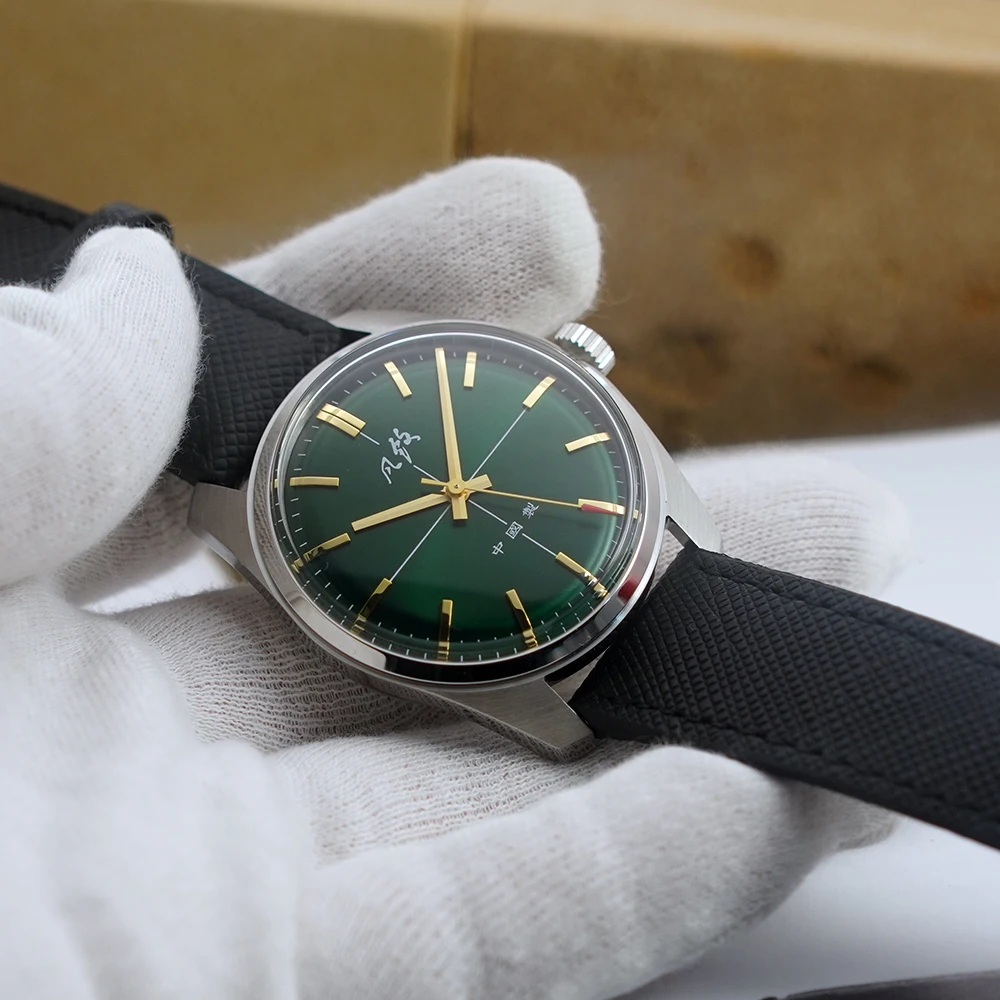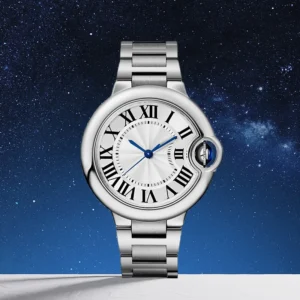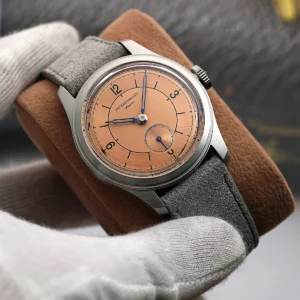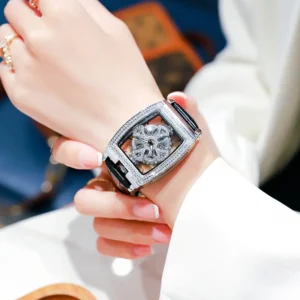Introduction: The Allure of a Slim Profile
Picture the moment: a sleek timepiece glides effortlessly beneath a crisp shirt cuff, catching the light with subtle brilliance while maintaining an air of understated sophistication. This is the magic of a thin case watch—a harmonious blend of engineering precision and aesthetic refinement that has captivated watch enthusiasts for generations.
In the world of horology, “thin” typically refers to watches with cases measuring under 8mm in thickness, while those classified as “ultra-thin” often measure less than 5mm—sometimes even pushing boundaries below 2mm in record-breaking designs. These slim profiles represent not merely a style choice but a significant technical achievement in watchmaking.
The appeal of these slender timepieces continues to grow, resonating with those who appreciate both the practical comfort of a lightweight watch and the subtle elegance that comes with refined proportions. Whether it’s the discreet presence beneath business attire or the balanced weight distribution on the wrist, thin automatic dress watches offer an unmatched wearing experience.
In this comprehensive guide, we’ll explore what truly defines a thin watch, the remarkable benefits they offer, the engineering marvels that make them possible, and how to select the perfect slim timepiece for your collection. We’ll also examine why modern watches are thinner than ever before, representing a fascinating convergence of traditional craftsmanship and contemporary innovation.
What Defines a “Thin” Watch?
Understanding what constitutes a “thin” watch requires more than just a casual glance—it demands appreciation for the precise measurements and technical considerations that define this category of timepieces.
In contemporary watchmaking, classifications typically follow these general guidelines:
- Standard watch thickness: 9-14mm (0.35-0.55 inches)
- Thin watch thickness: Under 8mm (0.31 inches)
- Ultra-thin watch thickness: Under 5mm (0.2 inches)
- Record-breaking ultra-thin: Under 2mm (0.08 inches)
These definitions have evolved over time as watchmaking technology has advanced, with today’s “thin” measurements representing what might have been considered impossibly slim in earlier decades.
The primary factor determining a watch’s thickness is its movement—the internal mechanism that powers the timepiece. Different movement types offer varying potential for thinness:
Quartz movements naturally allow for slimmer profiles due to fewer moving parts and simpler construction. Many of the thinnest everyday watches utilize quartz technology.
Manual-winding mechanical movements traditionally offer better thinness potential than their automatic counterparts because they lack the self-winding mechanism that adds bulk. Many manual wind dress watches capitalize on this advantage.
Automatic movements present additional challenges for achieving thinness due to the rotor mechanism required for self-winding functionality, though innovations like micro-rotors and peripheral winding systems have helped overcome these limitations.
Beyond the movement, other factors significantly impact overall thickness:
- Case construction and material strength (thinner materials must be structurally sound)
- Crystal thickness and shape (domed versus flat)
- Caseback design (exhibition versus solid)
- Dial and hand clearance requirements
For a comprehensive understanding of how these measurements compare across different watch styles, the watch case thickness comparison guide provides invaluable insight into the nuances that define truly thin timepieces.
The Compelling Advantages of Thin Case Watches
Enhanced Wearability and Comfort
The most immediate benefit of a thin watch is its superior comfort during extended wear. Unlike bulkier timepieces that constantly remind you of their presence, slim watches seem to become one with the wrist. This lightweight profile distributes pressure more evenly, reducing fatigue even after wearing the watch all day.
The thin watch cases comfort analysis reveals that watches under 8mm thick typically cause significantly less wrist strain than their thicker counterparts. This comfort advantage becomes particularly apparent when typing at a computer or engaging in activities where a bulky watch might otherwise catch or snag on clothing and surfaces.
Additionally, the benefits of slim watch cases extend to their ability to stay securely positioned on the wrist without the shifting and sliding often experienced with heavier models. This stable positioning contributes significantly to the overall wearing comfort.
Timeless Elegance and Versatility
Thin watches have long been associated with formal attire and refined taste. Their ability to slide effortlessly beneath a shirt cuff—the classic “cuff test” that watch enthusiasts often reference—makes them ideal companions for business and formal settings. Navigating elegance with ultra-thin formal watches becomes effortless when the timepiece harmonizes with rather than disrupts your overall presentation.
The clean lines and restrained proportions of thin watches also align perfectly with contemporary minimalist automatic watches, making them versatile enough to transition from professional environments to casual settings without missing a beat. This adaptability makes thin watches particularly valuable for travelers or anyone seeking a “one watch” solution for varied situations.
Ideal for Various Wrist Sizes
Thin case designs offer significant advantages for those with smaller wrists, providing substantial dial presence without overwhelming proportions. The reduced height creates a more balanced appearance and prevents the “top-heavy” effect that thicker watches can create.
For those with average to larger wrists, thin watches provide a distinctly elegant alternative to bulkier sports models, allowing for greater stylistic versatility. The flat profile sits naturally against the wrist regardless of size, creating a seamless integration with the wearer’s physique.
Testament to Horological Excellence
Perhaps most significantly for enthusiasts, an ultra-thin watch represents the pinnacle of watchmaking skill. Creating a reliable, accurate mechanism within severely constrained space requires exceptional engineering ingenuity and finishing techniques. Many collectors appreciate thin watches precisely because they understand the technical challenges involved in creating them.
The pursuit of thinness in watchmaking has driven numerous innovations that have benefited the entire industry, from more efficient power transmission to advanced materials research. Each slim timepiece serves as a wearable demonstration of these achievements.

The Engineering Marvel: Creating Ultra-Thin Timepieces
Movement Innovation: The Heart of Thinness
At the core of any thin watch lies an ingeniously designed movement that maximizes efficiency while minimizing height. The engineering behind slim watch movements reveals several key strategies watchmakers employ to achieve remarkable thinness:
Micro-rotor technology represents one of the most significant innovations in thin automatic watches. Unlike traditional central rotors that sit atop the movement, micro-rotors are integrated within the plane of the movement itself, dramatically reducing overall thickness while maintaining winding efficiency.
Peripheral rotors offer another innovative approach, with the winding weight circling the perimeter of the movement rather than sitting above or within it. This arrangement preserves the full dial visibility enthusiasts appreciate while enabling thinner case profiles.
Component consolidation represents perhaps the most sophisticated approach to thinness. By ingeniously designing parts to serve multiple functions, watchmakers reduce the total number of components needed. Some ultra-thin calibers merge the mainplate and caseback into a single component, eliminating an entire structural layer from the watch.
Caliber architecture itself undergoes fundamental rethinking in ultra-thin design. Traditional bridges and plates give way to minimalist constructions where every micron is scrutinized for potential space savings. The gear train layout may be completely reimagined to operate efficiently in a flatter configuration.
Advanced Materials Science
Material selection plays a crucial role in achieving extreme thinness while maintaining structural integrity. Modern titanium automatic watches exemplify how lightweight metals contribute to the thin watch wearing experience, offering exceptional strength-to-weight ratios that allow for thinner components without sacrificing durability.
High-tech ceramic compounds, carbon composites, and specialized alloys enable watchmakers to push boundaries further than traditional metals would permit. These materials can maintain rigidity at thinner dimensions while resisting the flexing that would compromise a watch’s water resistance and structural integrity.
Sapphire crystal technology has similarly evolved to support the thin watch revolution. Modern production methods create highly resistant crystals that protect the watch face while maintaining minimal thickness, some measuring less than 0.5mm while still providing essential protection.
Design Challenges and Trade-offs
Creating ultra-thin timepieces involves navigating significant design challenges that require careful balance and compromise:
Power reserve limitations often accompany thinner movements due to smaller mainsprings. Many ultra-thin watches offer 40-48 hours of power rather than the extended 70+ hours found in thicker movements.
Water resistance presents particular difficulties, as the case compression required for high water resistance ratings typically demands thicker construction. Most ultra-thin watches compromise with modest ratings of 30-50 meters, suitable for everyday wear but not serious water activities.
Servicing complexity increases significantly with ultra-thin calibers. The densely packed components require extraordinary skill to disassemble and reassemble during maintenance, often necessitating service by specialists with specific training.
These engineering realities require consumers to consider their priorities carefully when selecting a thin timepiece, weighing aesthetic and comfort desires against practical considerations of robustness and serviceability.
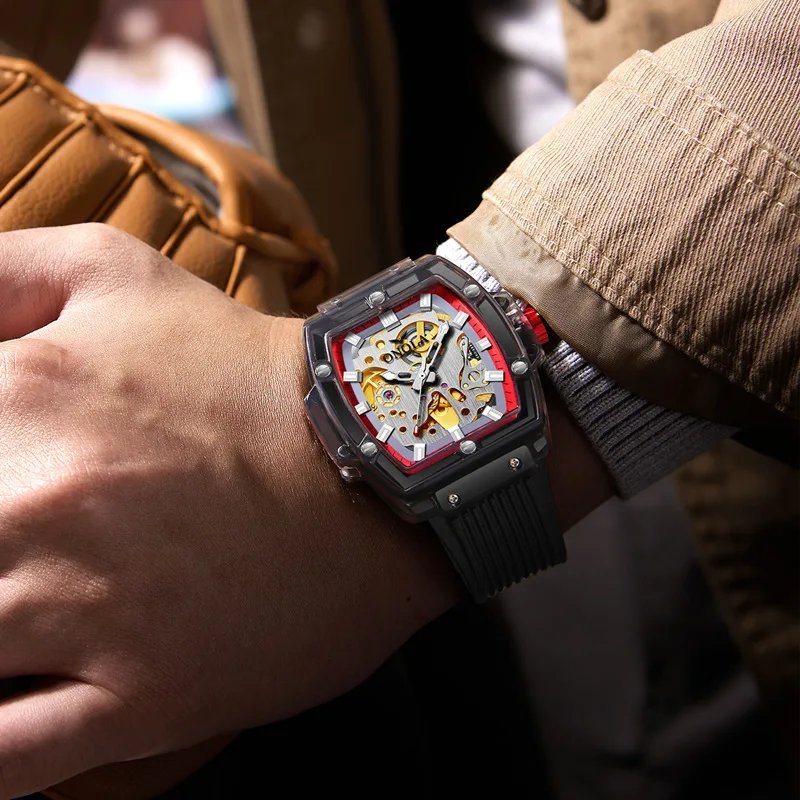
Evolution of Thinness: A Brief History
The pursuit of ever-thinner timepieces has been a continuous theme throughout watchmaking history, tracing an evolution of horological elegance that reflects both technical innovation and changing aesthetic preferences.
The journey began with pocket watches, where early efforts to create slimmer profiles responded to the fashion demands of aristocratic wearers. As these timepieces needed to slip comfortably into waistcoat pockets, watchmakers developed increasingly refined movements with flatter components.
The transition to wristwatches accelerated this trend, as the smaller canvas demanded greater efficiency in movement design. Early wristwatch calibers adapted pocket watch architecture to achieve thinner profiles suitable for wearing on the arm rather than in a pocket.
Significant breakthroughs occurred with the development of new escapement designs and mainspring configurations that allowed for flatter power delivery systems. The distinct features of dress watches began to crystallize during this period, with thinness emerging as a defining characteristic of refined timepieces.
The mid-century period saw fierce competition among Swiss manufacturers to claim records for the thinnest watches in various categories. Each new benchmark drove further innovation as brands sought horological prestige through technical miniaturization.
The quartz revolution temporarily shifted focus away from mechanical thinness, as battery-powered movements easily achieved slim profiles. However, the mechanical renaissance that followed reignited interest in ultra-thin watchmaking as a demonstration of traditional craftsmanship and engineering prowess.
Today’s thin watches represent the culmination of this historical progression, combining centuries of accumulated knowledge with modern materials and manufacturing techniques. The continued pursuit of thinness reflects not merely technical achievement but the enduring human appreciation for refinement and elegance in mechanical form.
Modern Thin Watch Exemplars Across Categories
Ultra-Luxury Masterpieces
At the pinnacle of thin watchmaking, several prestigious manufacturers create extraordinary timepieces that push the boundaries of what seems physically possible. These ultra-luxury thin watches feature movements measuring mere millimeters in thickness, often utilizing innovative construction methods where the case itself functions as part of the movement.
What distinguishes these masterpieces is not merely their thinness but the exquisite finishing lavished upon components that most owners will never see. Hand-beveled bridges, mirror-polished surfaces, and microscopic decorative techniques reflect hundreds of hours of artisanal effort, elevating these watches to museum-worthy creations.
Many of these record-breaking thin watches represent limited production pieces, with some brands producing fewer than 100 examples annually. Their prices reflect both their exclusivity and the extraordinary technical achievement they represent.
Elegant Dress Watches with Slim Profiles
The automatic dress watches category represents perhaps the most natural application of thin case design. These timepieces pair classic styling with refined proportions, creating versatile options for formal occasions and professional environments.
Characterized by clean dials, modest case diameters (typically 36-40mm), and subtle detailing, these watches embody horological restraint. Many feature simple time-only displays, though some incorporate small seconds or date complications without compromising their slim profiles.
Classic automatic dress watches often draw inspiration from designs that emerged during the mid-century golden age of watchmaking. Their enduring appeal lies in proportions and aesthetics that transcend fashion trends, remaining perpetually relevant regardless of changing tastes.
Everyday Thin Watches: Practical Elegance
Bridging the gap between dress and sport, everyday thin watches balance refinement with practicality. These models typically feature slightly more robust construction than pure dress pieces, with modest water resistance ratings (50-100 meters) and more luminous elements for improved legibility.
Case materials often expand beyond traditional precious metals to include stainless steel, titanium, and even high-tech ceramics that enhance durability while maintaining elegant proportions. Bracelet integration receives particular attention in this category, as engineers work to create fluid connections between case and bracelet without adding bulk.
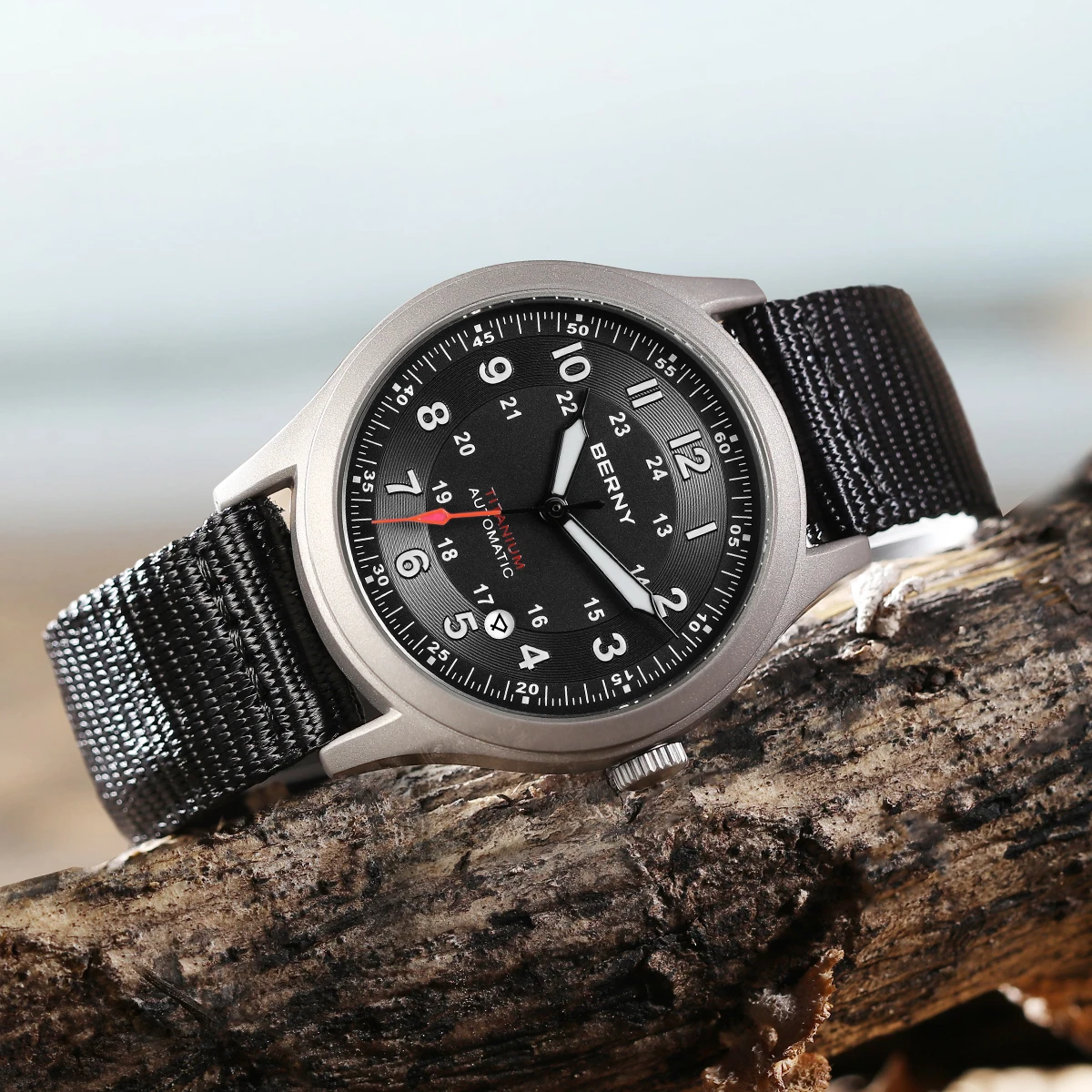
Affordable Thin Timepieces
The thin watch aesthetic has become increasingly accessible, with several brands offering impressively slim timepieces at attainable price points. While these watches may not challenge thickness records, they deliver the essential benefits of thin case design—comfort, versatility, and refined appearance—without requiring significant investment.
Many affordable thin watches utilize quartz movements to achieve their slim profiles cost-effectively, though mechanical options continue to expand as movement manufacturing becomes more efficient. These accessible options often serve as gateway pieces, introducing collectors to the pleasures of thin watches before they progress to higher-end offerings.
Modern manufacturing techniques have democratized precise case production, allowing brands at various price points to create well-finished thin cases that would have been possible only at premium levels previously. This democratization has significantly expanded the range of modern trends in thin watch profiles available to consumers at all budget levels.
Selecting Your Perfect Thin Watch: A Buyer’s Guide
Matching Your Lifestyle and Needs
Selecting the ideal thin watch begins with an honest assessment of your lifestyle and wearing habits. Consider these key questions:
- How formal is your typical daily environment? Pure dress watches excel in business and formal settings but might feel out of place in very casual contexts.
- What activities will you engage in while wearing the watch? Ultra-thin pieces may require more careful handling during active pursuits.
- How frequently will you wear this particular watch? Daily wear suggests prioritizing durability and ease of maintenance alongside thinness.
For professionals in traditional business environments, the formality of a dedicated dress watch makes perfect sense. Those with varied lifestyles might prefer the versatility of an everyday thin watch that transitions seamlessly between contexts.
Understanding Movement Types and Their Impact
Your choice of movement type significantly affects not just the watch’s thickness but also its character and maintenance requirements:
Quartz movements offer unmatched thinness, accuracy, and convenience, requiring minimal attention beyond occasional battery changes. They represent excellent value, particularly at entry-level price points, though they lack the emotional connection many feel to mechanical calibers.
Manual-wind mechanical movements achieve remarkable thinness through simplified construction. Classic manual-wind watches provide a direct connection to traditional watchmaking through the daily ritual of winding, though they require more regular attention than automatic alternatives.
Automatic mechanical movements balance convenience with horological appeal, winding themselves through the wearer’s natural motion. While typically slightly thicker than their manual counterparts, modern engineering has created automatic calibers approaching the thinness of hand-wound movements.
Material Considerations for Thin Cases
Case material selection impacts not only aesthetics but also how a thin watch feels on the wrist:
Stainless steel provides an excellent balance of durability and value, with versatile finishing options from sporty brushed surfaces to elegant polished treatments. Its substantial density means even thin steel watches maintain a reassuring presence on the wrist.
Titanium enhances the lightweight nature of thin watches through its exceptional strength-to-weight ratio. Approximately 40% lighter than steel, titanium creates an almost ethereal wearing experience while providing superior scratch resistance.
Gold and precious metals add luxury and warmth to thin watch designs, though their weight can partially offset the lightness of a slim profile. Their malleability requires careful engineering to maintain structural integrity in ultra-thin applications.
Ceramic and composite materials represent cutting-edge options for thin case construction, offering extreme hardness and scratch resistance with distinctive aesthetic properties. These materials enable some of the most technically advanced thin case designs.
Wrist Size and Proportion Guidance
The impact of a thin watch varies significantly based on individual wrist anatomy. Understanding the thin vs. thick watch cases profile relationship helps ensure harmonious proportions:
For smaller wrists (under 6.5 inches/16.5cm circumference), thin watches with moderate diameters (34-38mm) typically create the most balanced appearance. The reduced height prevents the watch from appearing top-heavy while maintaining adequate presence.
Medium wrists (6.5-7.5 inches/16.5-19cm) accommodate a wider range of diameter-to-thickness ratios, though thin watches with diameters between 36-40mm often prove most versatile across various settings.
Larger wrists (over 7.5 inches/19cm) can support thin watches with greater diameters (40-42mm) without compromising the elegant profile. The visual contrast between a wide dial and slim side profile creates a particularly sophisticated aesthetic on larger wrists.

Classic Automatic Dress Watches, Day Date Automatic Watches, Perpetual Calendar Automatic Watches
Price range: $540.60 through $574.60 Select options This product has multiple variants. The options may be chosen on the product pageClassic Automatic Dress Watches, GMT Automatic Watches, GMT Pilot Watches
Price range: $1,240.86 through $1,463.33 Select options This product has multiple variants. The options may be chosen on the product pageClassic Automatic Dress Watches, Thin Automatic Dress Watches
$437.64 Select options This product has multiple variants. The options may be chosen on the product pageProfessional Spec Dive Watches, Titanium Automatic Watches
$574.74 Select options This product has multiple variants. The options may be chosen on the product pageClassic Manual Wind Watches, Manual Wind Dress Watches
Price range: $425.50 through $462.50 Select options This product has multiple variants. The options may be chosen on the product page- $104.12 Select options This product has multiple variants. The options may be chosen on the product page
Beyond Thinness: Complementary Features
A truly successful thin watch design considers not just the case thickness in isolation but how various elements work together to enhance the perception of slenderness. Several complementary design features can dramatically affect how thin a watch appears and feels on the wrist.
Dial design plays a crucial role, with minimalist layouts and restrained typography reinforcing the clean aesthetic of thin cases. Monochromatic color schemes and sunburst or simple textured finishes tend to complement thin watches particularly well, while overly complex dial arrangements can visually contradict the streamlined case profile.
Bezel construction significantly impacts perceived thickness—slim, angled bezels that flow seamlessly into the case middle create an impression of exceptional thinness, while thick, flat bezels can make even relatively thin watches appear chunky. The angle and curvature of the bezel edge deserve particular attention when evaluating thin watch designs.
Case shape variation offers another dimension to consider, with certain geometries naturally lending themselves to thinner execution. Square and rectangular automatic watches often appear slimmer than their round counterparts due to their geometry and how they sit on the wrist. Tonneau (barrel) and cushion shapes can similarly create an impression of thinness through their extended proportions.
Strap and bracelet integration represents perhaps the most overlooked aspect of thin watch design. Straps that attach via spring bars set into drilled lugs add vertical height, while integrated designs where the strap or bracelet flows directly from the case maintain the slim profile throughout. The thickness and taper of the strap itself should ideally complement the case proportions rather than overwhelming them.
Caring for Ultra-Thin Timepieces
Thin watches, particularly ultra-thin mechanical models, benefit from specific care considerations to ensure their longevity:
Handle with appropriate pressure: When operating crowns and pushers on ultra-thin watches, use gentle, deliberate movements rather than firm pressure to avoid stressing delicate components.
Be mindful of impact: While modern thin watches are more robust than their vintage counterparts, they remain more susceptible to shock damage than thicker sport watches. Avoid activities with high impact potential while wearing ultra-thin pieces.
Respect water resistance limitations: Most thin watches offer modest water resistance (30-50 meters), sufficient for handwashing but not for swimming or showering. Always verify the specific rating for your model and respect these boundaries.
Store flat and secure: When not being worn, store thin watches flat in a padded watch box to prevent potential case distortion over time. This is particularly important for precious metal ultra-thin pieces.
Maintain regular service intervals: Thin mechanical movements benefit from more frequent servicing than standard calibers—typically every 3-5 years rather than 5-7 years—due to their more delicate construction and tighter tolerances.
Consider temperature extremes: Ultra-thin cases transmit external temperature to the movement more rapidly than thicker designs. Avoid exposing these watches to extreme heat or cold, which can affect lubrication and timing performance.
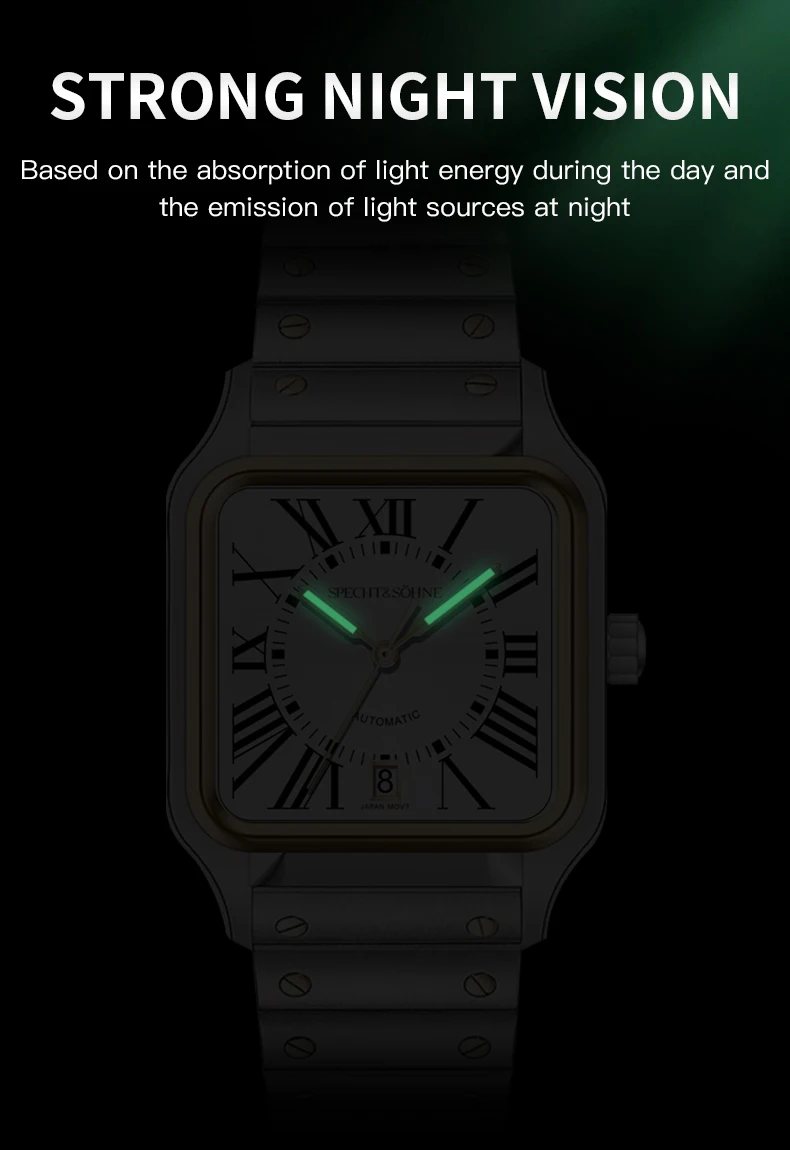
Innovation Frontiers: The Future of Thin Watchmaking
The pursuit of horological thinness continues to drive innovation across the watchmaking industry, with several promising frontiers suggesting exciting developments ahead.
Materials science represents perhaps the most dynamic area of advancement. Carbon nanotube composites and graphene-reinforced polymers show potential for creating cases and movement components that maintain strength at previously impossible dimensions. These materials could enable watches under 3mm in total thickness while enhancing rather than compromising durability.
Movement architecture continues to evolve, with several manufacturers exploring planar designs that distribute components horizontally rather than stacking them vertically. This approach reconsiders fundamental assumptions about caliber construction dating back centuries, potentially unlocking new thresholds of thinness.
Power generation alternatives beyond traditional mainsprings may further transform thin watch design. Energy harvesting technologies and advanced battery solutions could eventually eliminate the space requirements of mechanical power storage, though traditionalists will always value the purely mechanical approach.
The comparison between classic vs. minimalist dress watches reveals how different aesthetic philosophies approach thinness—traditional horology emphasizes the technical achievement within established design languages, while minimalist approaches strip away all non-essential elements to celebrate thinness as an aesthetic end in itself.
What remains certain is that the pursuit of thinness will continue to inspire watchmakers to question assumptions, reimagine possibilities, and push the boundaries of their craft. Each innovation contributes to the rich ongoing dialogue between form and function that defines fine watchmaking.
Is Ultra-Thin Right for You? Key Considerations
Does your lifestyle accommodate a potentially more delicate timepiece?
Ultra-thin watches generally require more mindful wear than robust sport models. If your daily activities involve physical work, frequent impacts, or harsh environments, you might consider reserving thin watches for specific occasions rather than everyday wear. However, many modern thin watches are more resilient than their vintage counterparts, making them suitable for normal professional and social settings.
Are you willing to accept potential service complexity for aesthetic benefits?
Ultra-thin mechanical movements typically require more specialized service than standard calibers, often at premium prices and potentially longer service times. This commitment represents part of the ownership experience for these sophisticated timepieces.
How important is the “heritage” aspect of thin watchmaking to your enjoyment?
For many enthusiasts, the historical significance and technical achievement represented by thin watches significantly enhance their appreciation. If you value the story and craftsmanship behind your timepieces, the rich tradition of thin watchmaking adds considerable depth to the ownership experience.
Would you prefer absolute thinness or a balance of slim profile with robust features?
The thinnest watches necessarily compromise certain practical features. Consider whether your priority is record-breaking slimness or a thoughtful balance of refinement and functionality that will serve you well in varied circumstances.
Conclusion: The Timeless Appeal of Thin Watch Design
The enduring fascination with thin watches transcends mere fashion trends, speaking to fundamental principles of refinement, engineering excellence, and practical elegance. These timepieces represent watchmaking in perhaps its purest form—the art of doing more with less, creating objects that serve their purpose beautifully while demonstrating remarkable restraint.
What makes thin watches particularly special is their dual achievement: they simultaneously represent technical virtuosity and everyday practicality. The same engineering that earns admiration from horology enthusiasts creates tangible benefits in comfort and versatility for the wearer.
As watchmaking continues to evolve, thin case designs remain a compelling testament to the harmonious balance between form and function. Whether expressed through centuries-old traditional craftsmanship or cutting-edge modern materials, the pursuit of thinness continues to inspire some of the most beautiful and wearable timepieces available.
For those who appreciate the subtle refinement of objects that excel through understated elegance rather than bold statements, a well-crafted thin watch offers enduring satisfaction—a daily companion that rewards close attention while never demanding it.

